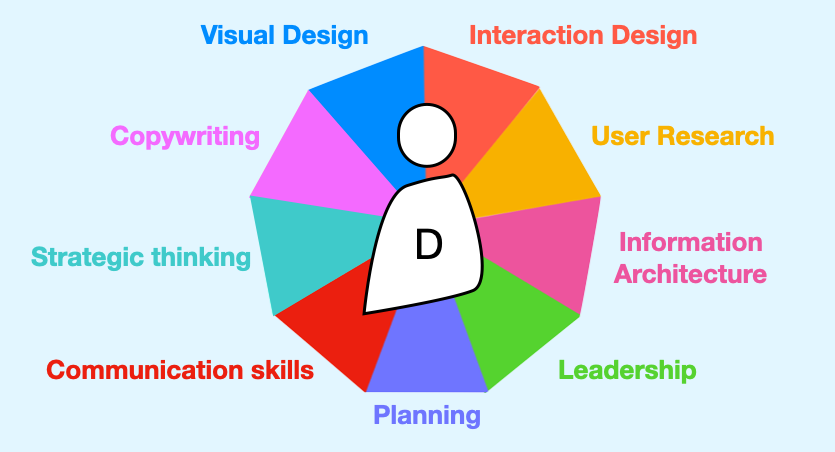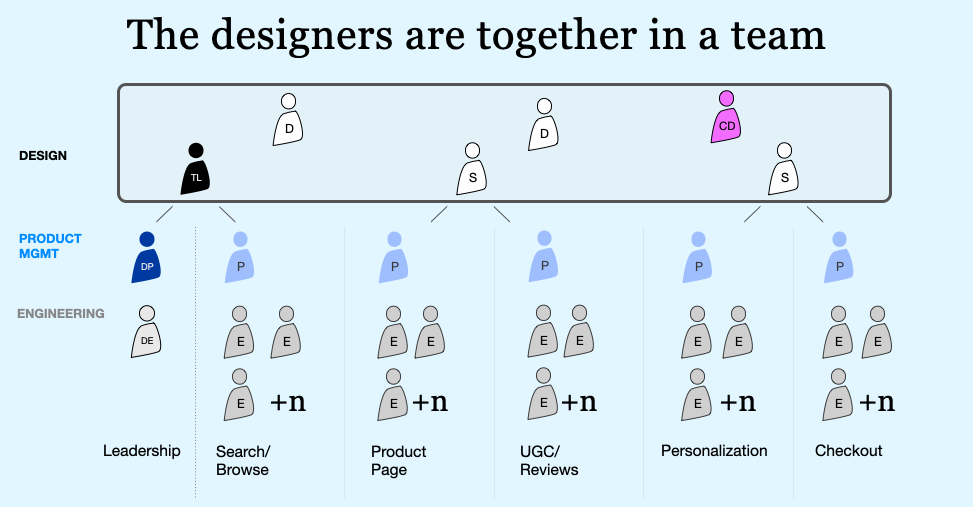“Agile” product practices, whether, Scrum, SAFe, squads, etc., encourage the formation of independent, self-sustaining teams. As the importance of design has become more broadly understood, these ‘user-facing’ product teams often feature an embedded designer, working with a product manager (or product owner), and some number of engineers, as depicted in this diagram:
When you embed this designer, you’re now asking that individual to deliver across a daunting range of capabilities:
The plight of the Junior/Entry-level Designer
Any junior designer thrown into this situation struggles, as they don’t have the experience and expertise to handle this. Often, the Product Manager is a mid-career contributor, who doesn’t know how to coach up designers. So, the junior designer ends up acting as a production artist, serving at the behest of the Product Manager. I hear a lot about Design organizations that are seen primarily as production shops, and it’s almost always for this reason—the designers aren’t true peers to product and engineering, and are just expected to do what they’re told.
Given this, a common refrain I hear from design leaders is that they cannot hire junior designers, because they need to bring people on who can slot into this context and hold their own. This is exacerbated by the design leaders often being spread too thin, so they don’t have any capacity for mentorship.
So, junior designers are caught between a rock and a hard place:
- they’re hired into an untenable situation, and struggle to do anything more than be a production artist (and wonder why they bothered getting that fancy design degree if they can only practice 20% of what they learned)
- they keep hearing about how “there are not enough designers,” but they can’t get anyone to even talk to them about a job
Everyone suffers when we don’t make space for junior designers
This ends up creating additional stresses within design teams and the broader design industry. Within design teams, there’s a constant struggle to find senior talent, as these teams have no internal pipeline in which to mature designers, and senior designers are highly sought after in the recruiting market. Also, because there aren’t junior designers in the design team, the senior designers end up doing a lot of production-level work, which takes time away from more impactful, bigger-picture work, and which limits the strategic contribution that the design team is able to make within the organization. So then these senior designers get frustrated and burned out, and leave in order to find opportunities that are more fulfilling.
Within the broader design industry, there’s a recognition of a severe lack of talent to meet demand, but we end up getting in our own way as we continue to forsake training up junior designers.
A way forward: organize design around teams, not individuals
This challenge with junior designers is one of many reasons why I advocate thinking of building design orgs at the level of team, not the individual.
In this model, instead of embedding designers within product teams, designers are pulled out into their own team, working across set of product teams addressing some contiguous aspect of the user experience. Instead of needing each designer to be an identical unicorn, a team of designers can have a range of experience and a variety of skill sets. The “S” designers are Senior designers who maintain the relationship with Product Managers across two product teams. They engage that Product Manager as a true peer, not as someone who just tells them what to do. The “D” designers are junior and mid-level designers who can float to where they are needed. They don’t work on their own, but always with the guidance of a senior designer or the Team Lead (TL). This is how they develop their practice. (Unrelated, but worth calling out: Since we’re operating as a team, team members can have distinct skill depths. So, here, we have a Content Designer (“CD”) who can bring expertise in writing and information architecture to the work being done.)
Through a model such as this, we have made room to bring in junior designers, situate them in a way that they can learn and grow, enable more Senior designers to focus on higher order challenges, and have created an internal pipeline to develop team members so they become our next generation of senior designers as we need them.
“Agile” orthodoxy is harmful to the practice of design
To simply follow standard practices for “Agile” development (I’m putting “Agile” in quotes because I recognize that these practices often conflict with the original intent of the Agile movement), is to sell short the future of design as a function and a practice. We need design leaders to advocate for organizational structures and processes that enable design to deliver on its potential, or we will continue to see designers treated as subservient to other functions, order takers with little agency in their work.



 I’m thinking about this as I read Patrick Lencioni’s
I’m thinking about this as I read Patrick Lencioni’s